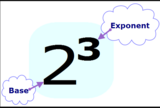
Students understand the meaning of exponents.
- Subject:
- Mathematics
- Material Type:
- Lesson Plan
- Author:
- Angela Vanderbloom
- Date Added:
- 07/04/2018

Students understand the meaning of exponents.

In earlier modules, students analyze the process of solving equations and developing fluency in writing, interpreting, and translating between various forms of linear equations (Module 1) and linear and exponential functions (Module 3). These experiences combined with modeling with data (Module 2), set the stage for Module 4. Here students continue to interpret expressions, create equations, rewrite equations and functions in different but equivalent forms, and graph and interpret functions, but this time using polynomial functions, and more specifically quadratic functions, as well as square root and cube root functions.
Find the rest of the EngageNY Mathematics resources at https://archive.org/details/engageny-mathematics.

(Nota: Esta es una traducción de un recurso educativo abierto creado por el Departamento de Educación del Estado de Nueva York (NYSED) como parte del proyecto "EngageNY" en 2013. Aunque el recurso real fue traducido por personas, la siguiente descripción se tradujo del inglés original usando Google Translate para ayudar a los usuarios potenciales a decidir si se adapta a sus necesidades y puede contener errores gramaticales o lingüísticos. La descripción original en inglés también se proporciona a continuación.)
En módulos anteriores, los estudiantes analizan el proceso de resolver ecuaciones y desarrollar fluidez en la escritura, interpretación y traducción entre varias formas de ecuaciones lineales (Módulo 1) y funciones lineales y exponenciales (Módulo 3). Estas experiencias combinadas con el modelado con datos (Módulo 2), preparan el escenario para el módulo 4. Aquí los estudiantes continúan interpretando expresiones, crean ecuaciones, reescriben ecuaciones y funciones en formas diferentes pero equivalentes, y gráficos e interpretan funciones, pero esta vez utilizando polinomial funciones y funciones más específicamente cuadráticas, así como funciones de raíz de raíz cuadrada y de cubos.
Encuentre el resto de los recursos matemáticos de Engageny en https://archive.org/details/engageny-mathematics.
English Description:
In earlier modules, students analyze the process of solving equations and developing fluency in writing, interpreting, and translating between various forms of linear equations (Module 1) and linear and exponential functions (Module 3). These experiences combined with modeling with data (Module 2), set the stage for Module 4. Here students continue to interpret expressions, create equations, rewrite equations and functions in different but equivalent forms, and graph and interpret functions, but this time using polynomial functions, and more specifically quadratic functions, as well as square root and cube root functions.
Find the rest of the EngageNY Mathematics resources at https://archive.org/details/engageny-mathematics.
The resource leads to an interactive website where students can learn and practice arithmetic essentials. Currently these are Mean and Median, Exponents, Square Roots and Arithmetic Sequences. I hope to be expanding the website as time allows.
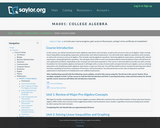
This course is also intended to provide the student with a strong foundation for intermediate algebra and beyond. Upon successful completion of this course, you will be able to: simplify and solve linear equations and expressions including problems with absolute values and applications; solve linear inequalities; find equations of lines; and solve application problems; add, subtract, multiply, and divide various types of polynomials; factor polynomials, and simplify square roots; evaluate, simplify, multiply, divide, add, and subtract rational expressions, and solve basic applications of rational expressions. This free course may be completed online at any time. It has been developed through a partnership with the Washington State Board for Community and Technical Colleges; the Saylor Foundation has modified some WSBCTC materials. (Mathematics 001)
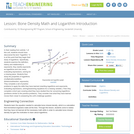
In their reading from activity 1 of this unit, students should have discovered the term "logarithm." It is at this point that they begin their study of logarithms. Specifically, students examine the definition, history and relationship to exponents; they rewrite exponents as logarithms and vice versa, evaluating expressions, solving for a missing piece. Students then study the properties of logarithms (multiplication/addition, division/subtraction, exponents). They complete a set of practice problems to apply the skills they have learned (rewriting logarithms and exponents, evaluating expressions, solving/examining equations for a missing variable.) Then they complete a short quiz covering what they have studied thus far concerning logarithms (problems similar to the practice problems). They consider how what they have learned moves them closer to answering the unit's challenge question.
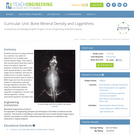
Students examine an image produced by a cabinet x-ray system to determine if it is a quality bone mineral density image. They write in their journals about what they need to know to be able to make this judgment. Students learn about what bone mineral density is, how a BMD image can be obtained, and how it is related to the x-ray field. Students examine the process used to obtain a BMD image and how this process is related to mathematics, primarily through logarithmic functions. They study the relationship between logarithms and exponents, the properties of logarithms, common and natural logarithms, solving exponential equations and Beer's law.
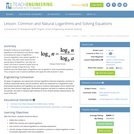
Students continue an examination of logarithms in the Research and Revise stage by studying two types of logarithms—common logarithms and natural logarithm. In this study, they take notes about the two special types of logarithms, why they are useful, and how to convert to these forms by using the change of base formula. Then students see how these types of logarithms can be applied to solve exponential equations. They compute a set of practice problems and apply the skills learned in class.

This is designed to be homework after you teach the interest formula

The purpose of this task is to introduce the idea of exponential growth and then connect that growth to expressions involving exponents. It illustrates well how fast exponential expressions grow.

This math problem demonstrates the concept of geometric progression, through an example of a million dollar contract between an employee and an employer. Application of the concept of geometric progression to social cause activism is addressed. This resource is from PUMAS - Practical Uses of Math and Science - a collection of brief examples created by scientists and engineers showing how math and science topics taught in K-12 classes have real world applications.
![Evolution of Tusklessness in African Elephants [version 1.0]](https://oercommons.org/static/newdesign/images/materials/default-thumbnail-index.png)
The exploitation of African elephants in the form of ivory poaching is exacerbated by warfare. The affects of this anthropogenic evolutionary force on the African savanna elephant (Loxodonta africana) in the Gorongoas National Park in Mozambique was investigated (Campbell-Staton, et. al. 2021) after the Mozambican civil war (1997-1992). This multipart lesson is based on this research. Here, we explore allele frequencies, phenotypic data, and the use of a chi-squared test to determine if the population is in Hardy-Weinberg Equilibrium. Because one gene influencing tusklessness is X-linked, we also explore inheritance of the trait, using hemophilia as an example. The data used in this part of the lesson are simulated data based on reports from Zambia.

The Exponents and Radicals module is separated into two parts -- exponents and radicals. Each part has two subtopics. Each subtopic has a video lecture page and a practice assignment. The video lecture page includes guided notes in pdf form and videos that follow the guided notes. There are also Word document versions of the notes in the "files" section of this course for instructor convenience. Each video lecture page also includes supplemental YouTube videos which are optional for students and may be used if further instruction is needed. The practice assignment is a set of exercises in Derivita that correspond to the skills covered in the video lecture.There are also two review assignments in this module -- one for exponents and one for radicals. These assignments cover everything from that part of the module, rather than being broken up into parts like the practice assignments. So there are a total of six assignments in the module and instructors can choose which assignments are most appropriate for their students' needs.This work, by Madilyn Marshall, is licensed under a Creative Commons Attribution 4.0 International License.CC-BY

The Factoring module is separated into two parts -- factoring numbers and factoring algebraic expressions. Each part has subtopics. Each subtopic has a video lecture and a practice assignment. The video lecture page includes guided notes in pdf form and videos that follow the guided notes. Each video lecture page also includes supplemental YouTube videos which are optional for students and may be used if further instruction is needed. The practice assignment is a set of exercises in Derivita that correspond to the skills covered in the video lecture.This work, by Magdalene (Maxie) Inigo, is licensed under a Creative Commons Attribution 4.0 International License.Links to an external site.CC-BY
![Fitting Exponential and Logistic Growth Models to Bacterial Cell Count Data [version 1.0]](https://oercommons.org/static/newdesign/images/materials/default-thumbnail-index.png)
In this activity, students will model a noisy set of bacterial cell count data using both exponential and logistic growth models. For each model the students will plot the data (or a linear transformation of the data) and apply the method of least squares to fit the model's parameters. Activities include both theoretical and conceptual work, exploring the properties of the differential equation models, as well as hands-on computational work, using spreadsheets to quickly process large amounts of data. This activity is meant as a capstone to the differential calculus portion of a typical undergraduate Calculus I course. It explores a biological application of a variety of differential calculus concepts, including: differential equations, numerical differentiation, optimization, and limits. Additional topics explored include semi-log plots and linear regression.
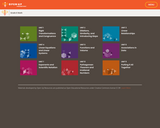
Student-facing 8th grade math resources. Covers transformations & congruence, slope, similarity, linear relationships, associations in data, volume, functions, scientific notation, the pythagorean theorem and irrational numbers.
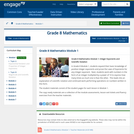
In Grade 8 Module 1, students expand their basic knowledge of positive integer exponents and prove the Laws of Exponents for any integer exponent. Next, students work with numbers in the form of an integer multiplied by a power of 10 to express how many times as much one is than the other. This leads into an explanation of scientific notation and continued work performing operations on numbers written in this form.
Find the rest of the EngageNY Mathematics resources at https://archive.org/details/engageny-mathematics.

In this classic hands-on activity, learners estimate the length of a molecule by floating a fatty acid (oleic acid) on water. This lab asks learners to record measurements and make calculations related to volume, diameter, area, and height. Learners also convert meters into nanometers. Includes teacher and student worksheets but lacks in depth procedure information. The author suggests educators search the web for more complete lab instructions.
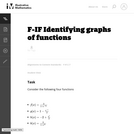
The goal of this task is to get students to focus on the shape of the graph of the equation y=ex and how this changes depending on the sign of the exponent and on whether the exponential is in the numerator or denominator. It is also intended to develop familiarity, in the case of f and k, with the functions which are used in logistic growth models, further examined in ``Logistic Growth Model, Explicit Case'' and ``Logistic Growth Model, Abstract Verson.''
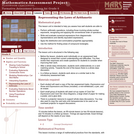
This lesson unit is intended to help you assess how well students are able to: Perform arithmetic operations, including those involving whole-number exponents, recognizing and applying the conventional order of operations; Write and evaluate numerical expressions from diagrammatic representations and be able to identify equivalent expressions; apply the distributive and commutative properties appropriately; and use the method for finding areas of compound rectangles.